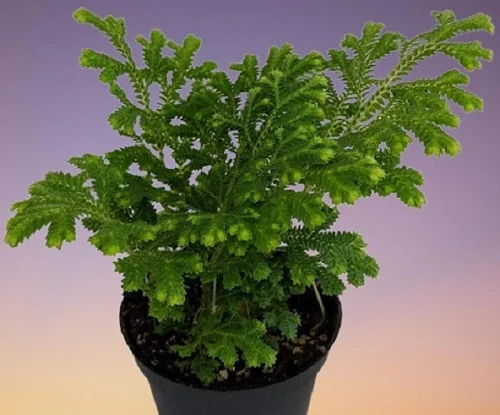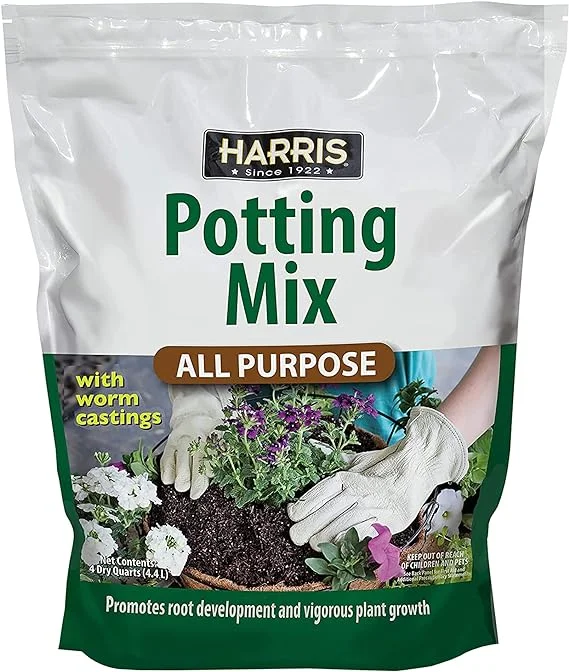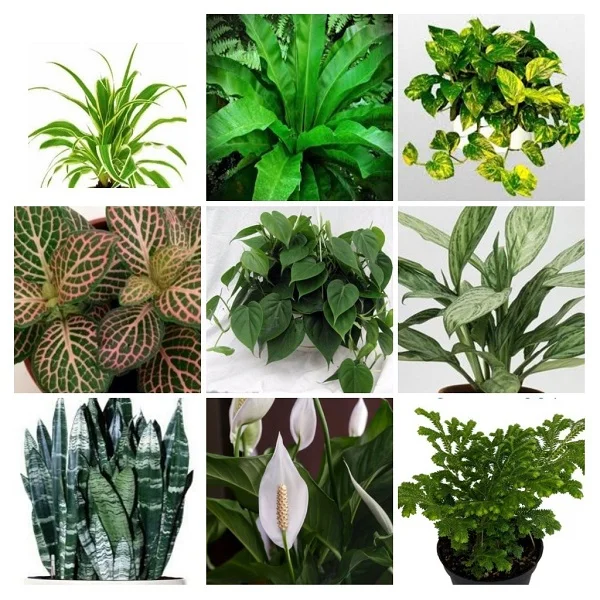Creeping Moss (Selaginella) Indoor Care, Propagation, Problems and Solutions
Some links in this post may be affiliate links
Creeping Moss (Selaginella) prospers in bright indirect light, warm and humid conditions and consistently moist, rich, well-drained soils coupled with monthly feeding in the growing season.
Selaginella is a creeping plant with simple, scale-like leaves borne on branching stems from which the roots arise and is ideal for a terrarium as its tiny leaves will shrivel in ordinary room conditions.
To increase your chance of success in growing Creeping moss indoors, grow the plant in a shallow, well drained pot in semi-shade away from the window and direct sunlight.
Then, surround the pot with damp moss or set it on a wet pebble tray to raise humidity. Use only soft water to water and mist Creeping Moss.
On account of to its need for warm and humid conditions, Selaginella is one of the best plants for a closed terrarium.

Botanical name: Selaginella
Family: Selaginellaceae
Origin
The Selaginella plants occur mostly in the tropical regions of the world, with a handful of species to be found in the arctic-alpine zones of both hemispheres. A few species of Salaginella are desert plants known as "resurrection plants" which curl up in a tight, brown or reddish ball during dry times and uncurl and turn green in the presence of moisture.
Toxicity
Creeping Moss (Selaginella) are non-toxic to both humans and pets as indicated by ASPCA. They are safe to grow indoors.
Varieties
These tropical plants look like ferns. There are over 750 species of Selaginella. They have scale-leaves and spores of two types; a microspore male which is smaller and a megaspore female which is larger.
Some of the common species of Selaginella are the trailing types like Selaginella uncinata (Blue-green Peacock Fern). Selaginella apoda (pale green and moss-like). Selaginella kraussiana aurea (the yellow-green Spreading Clubmoss).
Some have upright stems like Selaginella martensii (Spike Moss) which has 1 ft upright stems and aerial roots which grow down from the stems into the soil.
Selaginella emmeliana has 6 in. erect stems and lacy leaves. Another common species is the resurrection-plant Selaginella lepidophylla which is bought as a dried-up ball and is restored to life by soaking in water.
Where to Buy
If you would like to add the Creeping Moss to your plant collection, you may get them online from Etsy (Link to Etsy).
Selaginella Care Indoors
Creeping Moss (Selaginella) blossoms in bright indirect light, average warmth of 18-280C, humidity of 70-80% and consistently moist, rich, well-drained, all purpose soils coupled with monthly feeding during the growing season.
Selaginella requires regular pruning to keep it neat, to reduce pest infestations, to encourage bushy growth and rejuvenate growth. Repotting is necessary only when the plant becomes pot-bound. Keep reading for more on these growing conditions and how to achieve them.

Light Requirements
Creeping Moss grows best in bright indirect light (dappled light). Keep it away from direct sunlight as it can scorch the plant resulting in ugly brown marks.
Selaginella will also thrive under grow lights if the natural lighting is not sufficient. Get full spectrum grow lights from Amazon.
Regularly rotate the pot to ensure that the plant receive light on all sides to promote uniform growth.
Watering
Water Creeping Moss thoroughly to keep soil moist at all times during the growing season. Reduce watering in the cold season to maintain the soil slightly moist as growth is reduced at this time but do not allow the soil to dry out completely.
Use tepid water (water at room temperature) to avoid shocking this tropical plant. In addition, the water should only be chlorine-free water as the plant is sensitive to chlorine and other chemicals dissolved in water.
Make sure that the pot has a drainage hole to prevent the soil from getting soggy as it may result in root-rot and eventual loss of the plant.
Temperature and Humidity
Average warmth of 18-280C is ideal for Creeping Moss. A room temperature that is comfortable for you is ideal for this plant. Keep it away from drafts to prevent sudden changes in temperature as they can cause wilting, leaf drop and drooping.
Selaginella requires high humidity of 70-80% to thrive. To raise humidity, set the pot on a wet pebble tray or use a cool mist humidifier. You can also grow the plant in a closed terrarium as a high humidity can be maintained inside a closed terrarium.
Regularly clean the leaves by gently brushing off the dust with a soft brush. Ensure that there is good air circulation to discourage fungal diseases.
Fertilizer
Feed Creeping Moss monthly during the growing period with a balanced, liquid fertilizer for lush growth. Withhold feeding in the cold season as growth is minimal and feeding at this time can lead to fertilizer burn.
Potting Mix
The best soil for Creeping Moss should be rich in organic matter and free-draining to prevent it from getting soggy while providing the required nutrients. Most all purpose potting mixes are ideal for this plant.
Repotting
Repot Creeping Moss at the beginning of the growing season only when growth has began to suffer as the plant prefers to be slightly root-bound.
Use a pot 1 size larger than the current one and one that has a drainage hole to prevent the soil from getting soggy as it can lead to root-rot. Check out these ceramic pots with drainage holes and saucer on Amazon.
Pruning
Pruning Creeping Moss involves removal of dead and yellow leaves to maintain the plant neat and minimize pests infestation. To encourage a compact and bushy growth pinch off the growing tips regularly. If the plant becomes unruly, cut it back to rejuvenate growth. The foliage emanating from the pruning, can be used to propagate new plants.
Propagation
Creeping Moss (Selaginella) can be propagated at the beginning of the growing season from stem-tip cuttings or by plant division.
How to propagate Creeping Moss from stem-tip cuttings
Take 4-5 inches long stem-tip cuttings from a healthy Creeping Moss and strip off most of the lower leaves.
Insert the lower cut end of the cuttings in moist free-draining soil and place the set up in a warm, well-lit place away from direct sunlight.
Maintain the soil moist through out until new growth emerges on the cuttings.
Allow the new Selaginella to be well established before transplanting after which you can begin routine care.
How to propagate Creeping Moss by plant divison
Take the Creeping Moss out of its pot and carefully divide the plant into several sections.
Pot these sections in moist free-draining soil in individual pots.
Ensure that the pots for the cuttings have a drainage hole inorder to prevent the soil from getting soggy as it can lead to rotting.
Place these pots in a warm, well-lit place and maintain the soil moist through out until new growth emerges on the cuttings.
Allow the new Selaginella to be well established before transplanting after which you can begin routine care.

Selaginella Growing Problems
Creeping Moss (Selaginella) growing problems include shrivelled leaves, rotting, plant death, pests and diseases among others. Keep reading for more on these problems and how to fix them.
Pests
The common pests in Creeping Moss are mealy bugs and spider mites which are prevalent in low humidity conditions. Isolate the affected plant to prevent spread to other plants and treat it with neem oil as per the manufacturer's instructions. Keep the plant properly pruned at all times to reduce the hiding places for these pests.
Brown and shrivelled leaves
brown and shrivelled leaves in Creeping Moss is caused by low air humidity. To increase humidity, set the pot on a wet pebble tray or use a cool mist humidifier. You may also grow the plant in a closed terrarium as a high humidity can be maintained inside a terrarium. Learn more on how to raise humidity for houseplants.
Rotting and dying
Rotting and dying in Creeping Moss is caused by root-rot which is promoted by soggy soil due to poor soil drainage. Always ensure that the pot has a drainage hole and the soil is free-draining to prevent the soil from getting soggy.
You liked it? Share on social media.
Related Content
Amazon Associates Disclosure
Homeplantsguide.com is a participant in the Amazon Services LLC Associates Program, an affiliate advertising program designed to provide a means for sites to earn advertising fees by advertising and linking to amazon.com.





